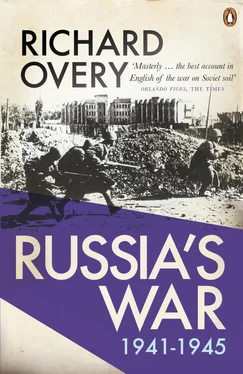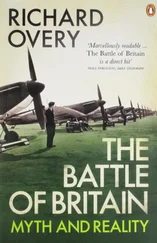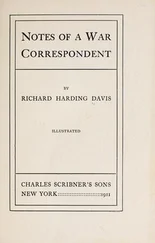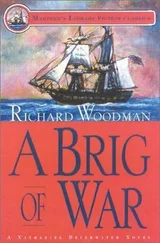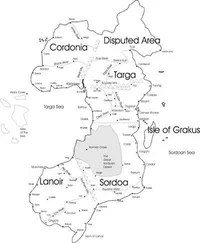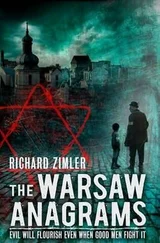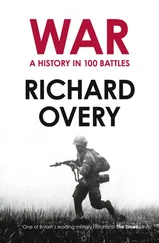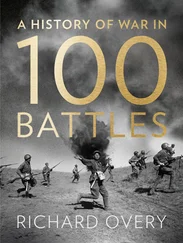Richard Overy - Russia's War
Здесь есть возможность читать онлайн «Richard Overy - Russia's War» — ознакомительный отрывок электронной книги совершенно бесплатно, а после прочтения отрывка купить полную версию. В некоторых случаях можно слушать аудио, скачать через торрент в формате fb2 и присутствует краткое содержание. Город: London, Год выпуска: 1999, ISBN: 1999, Издательство: Penguin Books Ltd, Жанр: military_history, на английском языке. Описание произведения, (предисловие) а так же отзывы посетителей доступны на портале библиотеки ЛибКат.
- Название:Russia's War
- Автор:
- Издательство:Penguin Books Ltd
- Жанр:
- Год:1999
- Город:London
- ISBN:978-0-14-192512-7
- Рейтинг книги:4 / 5. Голосов: 1
-
Избранное:Добавить в избранное
- Отзывы:
-
Ваша оценка:
- 80
- 1
- 2
- 3
- 4
- 5
Russia's War: краткое содержание, описание и аннотация
Предлагаем к чтению аннотацию, описание, краткое содержание или предисловие (зависит от того, что написал сам автор книги «Russia's War»). Если вы не нашли необходимую информацию о книге — напишите в комментариях, мы постараемся отыскать её.
[Contain tables. Best viewed with CoolReader.]
Russia's War — читать онлайн ознакомительный отрывок
Ниже представлен текст книги, разбитый по страницам. Система сохранения места последней прочитанной страницы, позволяет с удобством читать онлайн бесплатно книгу «Russia's War», без необходимости каждый раз заново искать на чём Вы остановились. Поставьте закладку, и сможете в любой момент перейти на страницу, на которой закончили чтение.
Интервал:
Закладка:
The question of Soviet security was central to the development of the Soviet system. The Soviet state found itself, in Lenin’s famous mixed metaphor, ‘an oasis in the middle of the raging imperialist sea’. 5Lenin counted on the Bolshevik example to provoke social revolution in the rest of Europe, so that the isolation would be overcome. In March 1919 an international Communist organization, the Comintern, was set up in Moscow. Its first task was to call on workers everywhere ‘to wipe out the boundaries between states, transform the whole world into one co-operative commonwealth’. Lenin promised the first assembly of the International that the victory of Communism throughout the world was only a matter of time. 6By the time of his death, in January 1924, that confidence had evaporated. The Soviet state was not in the vanguard of world revolution, but was an international pariah, perpetually on the defensive. Lenin’s successors could not agree among themselves whether security lay in the hope that imperialist competition would engulf capitalism and usher in world revolution or in the mobilization of the Soviet Union’s own resources to defend its own revolution. The former carried impossible risks. In 1925 the General Secretary of the Party, Josef Stalin, announced to Party leaders what was to become the chosen strategy for the regime, the building of ‘socialism in one country’. 7
The strategy of socialist self-defence made it imperative that the Soviet Union be adequately protected by military force. The position of the Red Army after the civil war was an uncertain one. It was regularly referred to as the Worker-Peasant Red Army to reflect its popular social base. Much of the civil war force melted away with the end of hostilities. Trotsky, who led the Red forces as head of the Revolutionary Military Council, established in April 1918, lost interest in military developments once the war was won. There was popular hostility to the officer corps on the grounds that the military élite constituted a threat of Bonapartist dictatorship, composed as it was of a great many officers unsympathetic to Bolshevism. Conditions in the armed forces were poor, with low pay, inadequate housing and limited career prospects. The place of the armed forces in a socialist society was poorly defined, their status insecure.
In January 1924, shortly after Lenin’s death, the Central Committee established a commission to review the whole question of the future of the military in the Soviet state. The findings represented a powerful indictment of Trotsky’s fading leadership. Many units had only half their officers. Out of 87,000 men trained to officer standard during the civil war, only 25,000 remained in service. Of the rest 30,000 were dead and approximately the same number demobilized. 8The supply situation was found to be anything but adequate, with insufficient weapons and poor levels of food and equipment. The rank and file were regarded as demoralized; their officers were condemned as ill-trained and unprofessional. Trotsky’s role was usurped by his deputy, Mikhail Frunze, a veteran civil war commander, who was to play a central part in shaping the development of the modern Red Army and Soviet military strategy. In January 1925 Trotsky was removed from his position as Chairman of the Military Council and Commissar for the Army and Navy, and Frunze took his place.
Though he held office for only ten months, until his death in October, Frunze achieved a great deal. Frunze’s view of the armed forces represented a compromise between those who saw them as an instrument of revolution, to be led by Communists and composed of a proletarian militia, and those like Tukhachevsky who favoured large professional armed forces equipped with modern weapons and free from political supervision. Frunze started from the point of view that war with any capitalist enemy would be a total war, drawing on all the social and economic reserves of the state as the civil war had done. He favoured the development of an offensive army, rooted in the proletariat. But to achieve forces capable of protecting the revolution required, he believed, large-scale industrialization, with a commitment to a major defence sector, and a programme of military education to turn workers into professional soldiers with a Communist outlook. Professionalism combined with revolutionary zeal was to be assured by organizing both a regular army, with enhanced status and powers for its officer corps, and a territorial militia of workers and peasants. 9
The organization was launched in 1924, but the first full call-up was achieved only in 1925 with a comprehensive military service law which laid down the foundation for the remarkable record of military mobilization achieved after 1941. For the regular soldiers the role of the political commissar, who had dominated the military system since the civil war, was downgraded, and full command responsibility was granted to officers. To counter the numerous complaints from Communist functionaries about the political unreliability of the officer corps, the proportion of Communists among the corps was increased. In 1925 over 40 per cent of the 76,000 officers and military officials were members of the Party. 10Frunze also tackled one of the major problems exposed by the 1924 review: low morale and poor discipline. For officers there were immediate improvements. A distinctive uniform was introduced to set them apart from the rank and file. They were given a generous pay rise and better living quarters. Above all, they were given the right to tell their men what to do. This was the most contentious issue of all, for under Order Number 1, issued by the Petrograd Soviet in the memorable spring of 1917, officers could be challenged by those they led. The object had been to make the army democratic, but it led, as might have been expected, to ordinary soldiers arguing for hours about whether to obey a particular order. Discipline was impossible under such conditions. Scant attention was paid to the regular routine of military life; observers found Red Army soldiers shabby and unkempt. In 1925 Frunze introduced a new disciplinary code. Though strongly opposed by Communists, who saw this as a return to the bad old habits of the imperial army, it was gradually implemented, restoring the right of officers both to order and to punish. 11
Frunze laid the foundation of the armed forces that fought the war against Germany, but he died before he saw the fruits of his reform programme in circumstances that remain obscure. He suffered from a chronic stomach complaint that doctors insisted required surgery, despite his protests. Stalin visited him in the hospital, where he pressured the surgeon to operate. Frunze died shortly afterwards. Foul play has never been proved. 12Frunze’s place was taken by one of Stalin’s closest political allies, Kliment Voroshilov. A former metalworker from the southern Ukraine, he was a military amateur, with little formal education and no military training. Most of his forty-four years had been spent as a terrorist and, first in 1905 then 1917, as a revolutionary. During the civil war he became a political soldier, like Stalin. He was an unprepossessing personality. Short and pig-nosed, he had nothing of the military dash of other civil war heroes. He was an intimate of Stalin’s from the civil war and remained part of the inner circle around the dictator for more than twenty years, a remarkable achievement in itself. He became Commissar of the Army and Navy (later changed to Commissar of Defence) in 1925 and kept the post until 1940. America’s wartime ambassador doubly damned him as a man who was ‘incompetent, but not dangerous’. 13
Voroshilov’s manifest ineptitude was compensated for by a second appointment in 1925. At the young age of thirty-two, Mikhail Tukhachevsky became chief of staff. A colonel in the Tsarist army, he had spent most of the Great War in a German prison camp. On his return he joined the Red Army and became an enthusiastic revolutionary and outstanding commander. He fought the campaign against the Poles in 1920 with Stalin as his political officer. His appointment was an inspired choice. What Voroshilov lacked in energy and experience was supplied by Tukhachevsky, a contrast that permanently soured relations between the two men. The chief of staff had one overriding ambition: to create a modern professional armed force fired with revolutionary élan. As did almost all the leading figures in the military establishment, Tukhachevsky saw the mass offensive as the strategy most appropriate to a revolutionary state. In 1926 he ordered a complete review of the armed forces and Soviet military doctrine. The fruit of that review, unambiguously titled The Future War , was published in May 1928. In it Tukhachevsky first laid out the idea that the grand offensive must be supported by thousands of tanks and armoured vehicles and thousands more aircraft, pouring forward at great speed to deliver to any enemy a knock-out blow of annihilating power. 14
Читать дальшеИнтервал:
Закладка:
Похожие книги на «Russia's War»
Представляем Вашему вниманию похожие книги на «Russia's War» списком для выбора. Мы отобрали схожую по названию и смыслу литературу в надежде предоставить читателям больше вариантов отыскать новые, интересные, ещё непрочитанные произведения.
Обсуждение, отзывы о книге «Russia's War» и просто собственные мнения читателей. Оставьте ваши комментарии, напишите, что Вы думаете о произведении, его смысле или главных героях. Укажите что конкретно понравилось, а что нет, и почему Вы так считаете.
